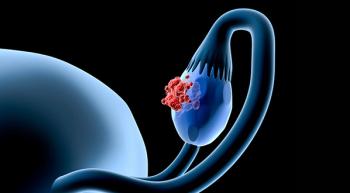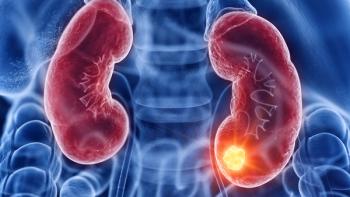
Ribociclib Plus Fulvestrant Leads to Longer PFS in Metastatic Breast Cancer

Patients with metastatic breast cancer who received ribociclib plus fulvestrant achieved a median progression-free survival of 18.1 months vs 5.29 months with placebo/fulvestrant.
Findings from the phase 2 MAINTAIN trial (NCT02632045) suggest that treatment with ribociclib (Kisqali) plus switch endocrine therapy offers patients with hormone receptor–positive, HER2-negative, metastatic breast cancer significant progression a significant progression-free survival (PFS) benefit compared with placebo plus switch endocrine therapy. The findings were previously presented at the
At a median follow-up of 18.2 months (interquartile range [IQR], 10.1-28.8), the median PFS was 5.29 months (95% CI, 3.02-8.12) in the ribociclib arm vs 2.76 months (95% CI, 2.66-3.25) in the placebo arm (HR, 0.57; 95% CI, 0.39-0.85; P = .006). The 6-month PFS rates with ribociclib and placebo were 41.2% (95% CI, 27.8%-54.6%) and 23.9% (95% CI, 12.8%-35%), respectively, and the 12-month PFS rates were 24.6% (95% CI, 12.5%-36.7%) and 7.4% (95% CI, 0.4%-14.3%), respectively.
Previously, clinical trials such as the phase 3 MONALEESA-2 study (NCT01958021) showed that ribociclib combined with endocrine therapy, in this case, letrozole, led to an overall survival (OS) benefit in postmenopausal patients with hormone receptor-positive, HER2-negative advanced breast cancer without prior exposure to CDK4/6 inhibitors.2 In MONALEESA-2, the median OS was 63.9 months (95% CI, 52.4-71.0) in the ribociclib arm vs 51.4 months (95% CI, 47.2-59.7) with placebo plus endocrine therapy.
“There remains an unmet need to determine the optimal sequencing of endocrine therapy with or without targeted therapy after disease progression with CDK4/6 inhibitor–based therapy,” lead study author, Kevin Kalinsky, MD, MS, of Winship Cancer Institute of Emory University in Atlanta, Georgia, and colleagues, wrote in a paper of the data.1
MAINTAIN treated 119 patients with hormone receptor-positive, HER2-negative, metastatic breast cancer who had progressed on endocrine therapy plus a CDK4/6 inhibitor. Eligible patients included female and male patients at least 18 years of age with histologically or cytologically confirmed disease. In addition, patients needed to have an ECOG performance status (PS) of 0 or 1, measurable or nonmeasurable disease, a baseline corrected QT interval no higher than 450 ms on an electrocardiogram, and normal marrow and organ function. Patients could have received 1 prior line of chemotherapy for metastatic breast cancer and must have completed any systemic anticancer therapy or radiotherapy at least 14 days before initiating the study treatment. However, no washout period was required between the completion of previous endocrine therapy or CDK4/6 inhibitor and study treatment initiation. Patients who were asymptomatic with previously treated brain metastases were eligible if they were off corticosteroids and were clinically stable for at least 4 weeks from definitive therapy completion.
Once enrolled, patients switched to another endocrine therapy from the endocrine therapy they had used prior to enrollment, either fulvestrant (Faslodex) or exemestane and were randomly assigned 1:1 to simultaneously receive either ribociclib at 600 mg once daily for 21 days on and 7 days off or placebo. Patients who had previously received fulvestrant received exemestane at 25 mg once daily. Patients who had previously received exemestane received intramuscular fulvestrant at 500 mg on days 1 and 15 of cycle 1 and on day 1 of every 4 weeks thereafter. Patients with no prior fulvestrant or exemestane exposure were encouraged to receive fulvestrant.
The primary end point of this trial was PFS, and secondary end points included overall response rate (ORR) per RECIST v1.1 criteria; clinical benefit rate (CBR), defined as the proportion of patients who experienced confirmed complete response (CR), partial response (PR), or stable disease at least 24 weeks from randomization; adverse effects (AEs); and blood markers such as circulating tumor DNA (ctDNA) detection.
At the data cutoff, 8 patients remained on treatment in the ribociclib arm, and 1 patient remained on treatment in the placebo arm. All patients but 1 were female, and patients had a median age of 59 years (IQR, 52-65) in the ribociclib arm and 55 years (IQR, 48-67) in the placebo arm. Overall, 65.4% (n = 78) of patients had an ECOG PS of 0.
Of the randomized patients, 86.5% (n = 103), and 11.7% (n = 14), and 1.7% (n = 2) had previously received CDK4/6 inhibition for metastatic breast cancer with palbociclib, ribociclib, and abemaciclib, respectively. The median duration of prior CDK4/6 inhibition was 15.5 months (IQR, 11.9-21) and 17 months (IQR, 11-23.5) in the ribociclib and placebo arms, respectively. Additionally, 67.2% (n = 80) of patients across both arms had received their previous CDK4/6 inhibitor for more than 12 months, 5.9% (n = 7) of patients received an intervening line of systemic therapy after progression on their prior CDK4/6 inhibitor, and 9.2% (n = 11) of patients received chemotherapy for metastatic breast cancer. Notably, 35% (n = 21) of patients in the ribociclib arm had de novo metastatic breast cancer compared with 54.2% (n = 32) of patients in the placebo arm.
In total, 83.2% (n = 99) of patients received fulvestrant as their switch endocrine therapy. An exploratory analysis demonstrated that patients who received ribociclib plus fulvestrant had a median PFS of 5.29 months (95% CI, 2.96-8.12) vs 2.76 months (95% CI, 2.66-3.25) in those who received placebo plus fulvestrant (HR, 0.60; 95% CI, 0.39-0.94). The investigators also observed a PFS benefit in the patients who received exemestane as switch endocrine therapy (n = 20) plus ribociclib vs those who received exemestane plus placebo (HR, 0.41; 95% CI, 0.14-1.24), although the authors noted the limitation of this small sample size.
The investigators tested 2-way interactions between each baseline attribute to determine intervention effects within subgroups. Of note were the hazard ratios for the duration of previous CDK4/6 inhibition, which were 0.36 (95% CI, 0.17-0.74) for the patients who received previous CDK4/6 inhibition for up to 12 months and 0.76 (95% CI, 0.47-1.24) for those who received previous CDK4/6 inhibition for more than 12 months, both favoring ribociclib plus endocrine therapy (P = .035). Additionally, the hazard ratios were similar between the patients who received prior palbociclib and those who received prior ribociclib, at 0.58 (95% CI, 0.38-0.90) and 0.50 (95% CI, 0.15-1.70), respectively (P = .805), and both favored ribociclib plus endocrine therapy, although the prior ribociclib estimate was based on a small cohort.
Additional results demonstrated that the ORR was 20% in the ribociclib arm and 11% in the placebo arm in the 70 patients with measurable disease (P = .51). Two patients in the ribociclib arm achieved a CR, and all other responses were PRs.
The CBR was 43% in the ribociclib arm vs 25% in the placebo arm (P = .06).
In total, 78 patients who received fulvestrant as their switch endocrine therapy had evaluable ctDNA at randomization. Of these patients, 42.3% (n = 33) had detectable ESR1 mutations, most of which were D538G and Y537S mutations. A total of 21.1% (n = 7) of these patients had both mutations.
In the patients with ESR1 mutations, co-occurring mutations included p53 mutations in 30.3% (n = 10) of patients, CCND1 alterations in 24.2% (n = 8) of patients, PIK3CA mutations in 21.2% (n = 7) of patients, and FGFR1 alterations in 18.2% (n = 6) of patients. In the patients without ESR1 mutations, 2% and 6% had CCND1 and FGFR1 amplifications, respectively.
In the patients who received fulvestrant as their switch endocrine therapy, the presence of at least 1 baseline ctDNA mutation was prognostic. Patients without detectable ESR1 mutations who received fulvestrant plus ribociclib achieved a PFS benefit compared with those who received fulvestrant plus placebo (HR, 0.30; 95% CI, 0.15-0.62). None of the 24 patients in the ribociclib arm without detectable ESR1 mutations had CCND1 and/or FGFR1 amplifications.
Patients with detectable ESR1 mutations who received fulvestrant had similar PFS outcomes in the ribociclib and placebo arms (HR, 1.22; 95% CI, 0.59-2.49). Of the patients in the ribociclib arm with detectable ESR1 mutations (n = 18), 50% (n = 9) had CCND1 and/or FGFR1 amplifications. Similar results were observed when patients with ESR1 Y537S mutations (n = 20) were removed from this analysis. The PIK3CA-mutant population that received ribociclib plus fulvestrant experienced no PFS benefit compared with placebo plus fulvestrant, although this was an exploratory analysis using a small cohort.
In total, 71.7%, 38.3%, and 1.7% of patients in the ribociclib arm (n = 60) and 15.3%, 0%, and 1.7% of those in the placebo arm (n = 59) experienced all-grade, grade 3, and grade 4 neutropenia, respectively. No other grade 4 AEs occurred.
Other AEs observed in the ribociclib arm were anemia (all-grade, 23.3%; grade 3, 1.7%), thrombocytopenia (25%; 0%), increased alanine transaminase (ALT; 16.7%; 0%), alopecia (3.3%; 0%), anorexia (10%; 0%), increased aspartate transferase (AST; 25%; 1.7%), cough (3.3%; 0%), diarrhea (15%; 0%), QTc prolongation (13.3%; 1.7%), fatigue (33%; 2%), headache (8.3%; 0%), hot flushes (5%; 0%), infection (10%; 5%), pneumonitis (3.3%, 1.7%), rash (3.3%; 0%), thromboembolic events (1.7%; 1.7%), and vomiting (15%; 0%). Other AEs observed in the placebo arm were anemia (all-grade, 22%; grade 3, 1.7%), thrombocytopenia (5.1%; 0%), increased ALT (20.3%; 1.7%), alopecia (3.4%; 0%), anorexia (11.9%; 0%), increased AST (28.8%; 6.8%), constipation (8.5%; 0%), cough (1.7%; 0%), diarrhea (10.2%; 0%), QTc prolongation (3.4%; 0%), fatigue (32.2%; 0%), headache (10.2%; 0%), hot flushes (3.4%; 0%), infection (5.1%; 0%), rash (5.1%; 0%), thromboembolic events (3.4%; 1.7%), and vomiting (5.1%; 0%).
Dose interruptions because of AEs were observed in 53% of patients in the ribociclib arm and 20% of patients in the placebo arm. Dose reductions because of AEs occurred in 25% of the ribociclib arm vs 8.5% of the placebo arm. Three treatment-related deaths occurred in 1 patient in each arm with pneumonia without fever or neutropenia and 1 patient in the ribociclib arm with sepsis, neutropenia, and disease progression.
“Ongoing trials will hopefully identify the ideal sequencing of endocrine therapy–based strategies to improve clinical outcomes while balancing toxicity and quality of life,” the study authors concluded.
References
- Kalinsky K, Accordino MK, Chiuzan C, et al. Randomized phase II trial of endocrine therapy with or without ribociclib after progression on cyclin-dependent kinase 4/6 inhibition in hormone receptor-positive, human epidermal growth factor receptor 2-negative metastatic breast cancer: MAINTAIN trial. J Clin Oncol. Published online May 19, 2023. doi:10.1200/JCO.22.02392
- Hortobagyi GN, Stemmer SM, Burris HA, et al. Overall survival with ribociclib plus letrozole in advanced breast cancer. N Engl J Med. 2022;386(10):942-950. doi:10.1056/NEJMoa2114663
Newsletter
Knowledge is power. Don’t miss the most recent breakthroughs in cancer care.
























































































